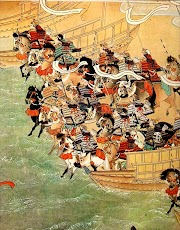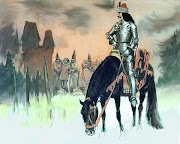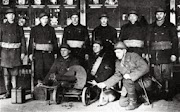Marshall Pétains shakes Adolph Hitler's hand, 1941
The Vichy collaborators in France and abroad formed a coalition/puppet government with their conquerors in the North of France while a 'free' southern zone was established rule by Vichy following the defeat of the French Army and the capture of Paris. The Vichy army fought rather poorly against their former Allies in North Africa while helping to cement fascist rule throughout occupied metropolitan France and Algeria.
Thousands of miles away in French Indochina where French rule had been established by imperial conquest beginning in 1862 as French Cochinchina (Vietnam), the Vichy government collaborated nominally with the Japanese in fear of being ousted by the Imperial Japanese Army (IJA) forces who were already poised to invade the region beginning in 1941-1942. The Vichy had around 35-40,000 soldiers in Southeastern Asia, of which less than 12,000 were Frenchmen or Europeans.
General Phibun (center) posing with his generals and a captured French Foreign Legion standard sometime in 1941
In the Franco-Thai War of 1940-1941 the Vichy French military forces were decisively defeated in every battle or action they fought during the greater land campaign of the conflict. Through the overwhelming combined arms (infantry, mechanized, aerial) assaults of the Royal Thai military, Thailand (Siam) won a total victory. The initial Thai offensive began in January 1941 with a large combined arms assault against French colonial positions in Laos and Cambodia.
Thai Vickers tank crew during the Franco-Thai War
French Foreign Legionnaires of the 5th Régiment (Etranger, 5e RE) during the 1941 war
Heavy fighting occurred in the Battambang Province in what is today Cambodia. The most notable action was fought at Yang Dam Koum where the French Division de Cochinchine-Cambodge (RC 1) and Cambodian Tirailleurs Regiment (RTC) were driven from the town after heavy fighting against the Thai assault. This French force was only saved from annihilation when a Legionnaire regiment reinforced their positions. Using 75mm 'flak' artillery guns they destroyed several Siamese tanks, halting the advance of the Thai army in the province for a time.
Battle of Koh Chang, January 1941
Knowing that they had to pressure the Thai from the sea, the Vichy French scored a small but nevertheless significant victory over the Royal Thai Navy at the Battle of Koh Chang, 16-17 January 1941. Remnants of the Marine Indochine formed into a Vichy French naval task force of gunboats-consisting of the light cruiser Lamotte-Piquet, the Dumont d’Urville, Amiral Charner, and the World War I/inter-war era gunboats Tahure and Marne.
French reconnaissance seaplanes spotted a Thai naval force comprised of the ships, the HTMS Thonburi, Chon Buri (Donburri), and Sri Ayuthia, and the torpedo boats Cholbury, Songkhla, and Trat anchored near the Koh Chang Islands off the southeastern coast of Thailand. The Vichy French task force sought out and opened fire on the Siamese warships who held fast. The battle lasted nearly two hours and was fought in relatively shallow waters for such large ships. Though both sides sustained heavy damage and significant losses, the Thai force was crippled. The Chon Buri, Cholbury, and Songkhla were all sunk and the flagship cruiser, HTMS Thonburi was later wrecked after being badly damaged in Battle of Koh Chang.
HTMS Thonburi in action against the Vichy French Navy on January 17th, 1941
French colonial troops in Cambodia, 1941












